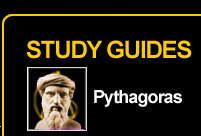






Pythagoras was born on the island of Samos, off the coast of Asia Minor. He was born to Pythais (a native of Samos) and Mnesarchus (a merchant from Tyre). As a young man, he left his native city for Croton in Southern Italy, to escape the tyrannical government of Polycrates. Many writers credit him with visiting the sages of Egypt and Babylon before going west; such travels feature in the biographies of many Greek sages.
Upon his migration from Samos to Croton, Pythagoras established a secret religious society very similar to (and possibly influenced by) the earlier Orphic cult.
Pythagoras undertook a reform of the cultural life of Croton, urging the citizens to follow virtue and form an elite circle of followers around himself. Very strict rules of conduct governed this cultural center. He opened his school to men and women students alike. Those who joined the inner circle of Pythagoras' society called themselves the Mathematikoi. They lived at the school, owned no personal possessions and were required to assume a vegetarian diet. Other students who lived in neighboring areas were also permitted to attend Pythagoras' school. Known as Akousmatics, these students were permitted to eat meat and own personal belongings.
According to Iamblichus, the Pythagoreans followed a structured life of religious teaching, common meals, exercise, reading and philosophical study. Music featured as an essential organizing factor of this life: the disciples would sing hymns to Apollo together regularly; they used the lyre to cure illness of the soul or body; poetry recitations occurred before and after sleep to aid the memory.
The Pythagorean theorem that bears his name was known earlier in Mesopotamia, Egypt and India. For a chronology of the theorem and its proofs, see the article on the Pythagorean theorem. Whether Pythagoras himself proved this theorem is not known, as it was common in the ancient world to credit to a famous teacher the discoveries of his students. The earliest known mention of Pythagoras's name in connection with the theorem occurred five centuries after his death, in the writings of Cicero and Plutarch.
The Golden Ratio
The golden ratio, also known as the golden proportion, golden mean, golden section, golden number, divine proportion or sectio divina, is an irrational number, approximately 1.618 033 988 749 894 848, that possesses many interesting properties.
Shapes proportioned according to the golden ratio have long been considered aesthetically pleasing in Western cultures, and the golden ratio is still used frequently in art and design, suggesting a natural balance between symmetry and asymmetry. The ancient Pythagoreans, who defined numbers as expressions of ratios (and not as units as is common today), believed that reality is numerical and that the golden ratio expressed an underlying truth about existence.
The golden ratio was first studied by ancient mathematicians because of its frequent appearance in geometry and may have even been understood and used as far back in history as the Egyptians. It is also believed that after tracing the path of Venus in the sky, they found that the ratio of the length of the long arm of the pentagon shape to the length of the shorter arm was 1.618 ... ... More commonly, however, the discovery of the golden ratio is ascribed to the ancient Greeks, and is usually attributed to Pythagoras (or to the Pythagoreans, notably Theodorus) or to Hippasus of Metapontum. Euclid spoke of the "golden mean" this way, "A straight line is said to have been cut in extreme and mean ratio when, as the whole line is to the greater segment, so is the greater to the lesser". The golden ratio is represented by the Greek letter (phi, after Phidias, a sculptor who commonly employed it) or less commonly by τ (tau).
Pythagoreans
Pythagoras' followers were commonly called "Pythagoreans." For the most part we remember them as philosophical mathematicians who had an influence on the beginning of axiomatic geometry, which after two hundred years of development was written down by Euclid in The Elements.
The Pythagoreans were instructed orally. They observed a rule of silence called echemythia, the breaking of which was punishable by death. In his biography of Pythagoras (written seven centuries after Pythagoras's time) Porphyry stated that this silence was "of no ordinary kind." The Pythagoreans were divided into an inner circle called the mathematikoi ("mathematicians") and an outer circle called the akousmatikoi ("listeners"). Porphyry wrote "the mathematikoi learned the more detailed and exactly elaborate version of this knowledge, the akousmatikoi (were) those which had heard only the summary headings of his (Pythagoras') writings, without the more exact exposition." According to Iamblichus, the akousmatikoi were the exoteric disciples who listened to lectures that Pythagoras gave out loud from behind a veil. The akousmatikoi were not allowed to see Pythagoras and they were not taught the inner secrets of the cult. Instead they were taught laws of behavior and morality in the form of cryptic, brief sayings that had hidden meanings. The akousmatikoi recognized the mathematikoi as real Pythagoreans, but not vice versa. After Pythagoras' death the two groups split from each other entirely, with Pythagoras' wife Theano and their two daughters leading the mathematikoi.
Theano, daughter of the Orphic initiate Brontinus, was a mathematician in her own right. She is credited with having written treatises on mathematics, physics, medicine, and child psychology, although nothing of her writing survives. Her most important work is said to have been a treatise on the principle of the golden mean. In a time when women were usually considered property and relegated at to the role of housekeeper or spouse, Pythagoras allowed women on equal terms in his society.
The Pythagorean society is associated with strange and superstitious prohibitions, such as not to step over a crossbar, not to touch a white cock, and not to eat beans. These rules seem like primitive pagan superstition, similar to "walking under a ladder brings bad luck," rules one cannot help but sneeze at. The abusive epithet mystikos logos ("mystical speech") was hurled at Pythagoras even in ancient times to discredit him. The key here is that "akousmata" means "rules," so that the superstitious taboos primarily applied to the akousmatikoi, and many of the rules were probably invented after Pythagoras' death and independent from the mathematikoi (arguably the real preservers of the Pythatorean tradition). The mathematikoi placed greater emphasis on inner understanding than did the akousmatikoi, even to the extent of dispensing with certain rules and ritual practices. For the mathematikoi, being a Pythagorean was a question of innate quality and inner understanding.
Beans, black and white, were the means used in voting. The maxim "abstain from beans" was perhaps nothing more than an exhortation to not vote. If true, this would be an excellent example of how ideas can be distorted when heard second hand and taken out of context. There was also another way of dealing with the akousmata - by allegorizing them. We have a few examples of this, one being Aristotle's explanations of them: "'step not over a balance', i.e. be not covetous; 'poke not the fire with a sword', i.e. do not vex with sharp words a man swollen with anger, 'eat not heart', i.e. do not vex yourself with grief," etc. We have evidence for Pythagoreans allegorizing in this way at least as far back as the early fifth century BC. This suggests that the strange sayings were riddles for the initiated.
The Pythagoreans are known for their theory of the transmigration of souls, and also for their theory that numbers constitute the true nature of things. They performed purification rites and followed and developed various rules of living which they believed would enable their soul to achieve a higher rank among the gods. Much of their mysticism concerning the soul seem inseparable from the Orphic tradition. The Orphics advocated various purifactory rites and practices as well as incubatory rites of descent into the underworld. Pythagoras is also closely linked with Pherekydes of Syros, the man ancient commentators tend to credit as the first Greek to teach a transmigration of souls. Ancient commentators agree that Pherekydes was Pythagoras' most intimate teacher. Pherekydes expounded his teaching on the soul in terms of a pentemychos ("five-nooks," or "five hidden cavities") - the most likely origin of the Pythagorean use of the pentagram, used by them as a symbol of recognition among members and as a symbol of inner health (ugieia).
It was the Pythagoreans who discovered that the relationship between musical notes could be expressed in numerical ratios of small whole numbers. The Pythagoreans elaborated on a theory of numbers the exact meaning of which is still debated among scholars.
Literary works
No texts by Pythagoras survive, although forgeries under his name — a few of which remain extant — did circulate in antiquity. Critical ancient sources like Aristotle and Aristoxenus cast doubt on these writings. And ancient Pythagoreans usually quoted their master's doctrines with the phrase autos ephe ("he himself said") — emphasizing the essentially oral nature of his teaching. Pythagoras appears as a character in the last book of Ovid's Metamorphoses , where Ovid has him expound upon his philosophical viewpoints.
Scientific contributions
Some consider Pythagoras the pupil of Anaximander and some ancient sources tell of his visiting, in his twenties, the philosopher Thales, just before the death of the latter. No account exists of the specifics of the meeting, other than the report that Thales recommended that Pythagoras travel to Egypt in order to further his philosophical and mathematical training. He is also supposed to have been a disciple of Pherekydes.
In astronomy, the Pythagoreans were well aware of the periodic numerical relations of the planets, moon, and sun. The celestial spheres of the planets were thought to produce a harmony called the music of the spheres. These ideas, as well as the ideas of the Platonic solids, would later be used by Johannes Kepler in his attempt to formulate a model of the solar system in his work The Harmony of the Worlds. Pythagoreans also believed that the earth itself was in motion and that the laws of nature could be derived from pure mathematics. They may have coined the term cosmos, a term implying a universe with orderly movements and events.
It is sometimes difficult to determine which ideas Pythagoras taught originally, as opposed to the ideas his followers later added. While he clearly attached great importance to geometry, classical Greek writers tended to cite Thales as the great pioneer of this science rather than Pythagoras. The later tradition of Pythagoras as the inventor of mathematics stems largely from the Roman period.
Whether or not we attribute the Pythagorean theorem to Pythagoras, it seems fairly certain that he had the pioneering insight into the numerical ratios which determine the musical scale, since this plays a key role in many other areas of the Pythagorean tradition, and since no evidence remains of earlier Greek or Egyptian musical theories. Another important discovery of this school -- which upset Greek mathematics, as well as the Pythagoreans' own belief that whole numbers and their ratios could account for everything in nature -- was the incommensurability of the diagonal of a square with its side. This result showed the existence of irrational numbers.
The influence of Pythagoras has transcended the field of mathematics, and the Hippocratic Oath — with its central commitment to First do no harm — has its roots in the oath of the Pythagorean Brotherhood.
This article is licensed under the GNU Free Documentation License. It uses material from the Wikipedia article "Pythagoras" and Wikipedia article "Golden Ratio".




